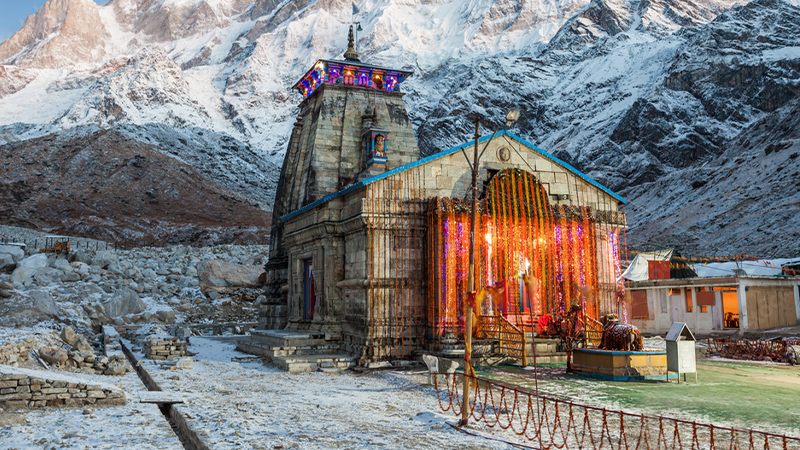Blog Details

Pilgrimage to Divinity: The Spiritual Odyssey of Kedarnath Yatra
Introduction:
The Himalayas, a majestic range known for its awe-inspiring beauty, cradle numerous sacred sites, each with its unique spiritual significance. Among these, the Kedarnath Temple stands as a testament to devotion, drawing pilgrims from across the globe. This article embarks on a journey through the mystic terrain of Kedarnath Yatra, unraveling the spiritual, historical, and natural facets that make it a pilgrimage like no other.
Historical Significance:
Nestled in the Garhwal Himalayas at an elevation of 11,755 feet, Kedarnath Temple holds immense historical and religious importance in Hinduism. Legend has it that the temple was built by Adi Shankaracharya in the 8th century as part of his efforts to revive Hinduism. Dedicated to Lord Shiva, Kedarnath is one of the twelve Jyotirlingas, representing the cosmic light of Lord Shiva.
The Yatra Commences:
The spiritual journey of Kedarnath Yatra typically begins in the months of April to November, as the harsh winter weather makes the region inaccessible during other times. Pilgrims embark on a trek of approximately 16 kilometers from Gaurikund to Kedarnath, passing through lush meadows, dense forests, and rustic villages that provide a glimpse into the Himalayan way of life.
The trek is not just a physical challenge; it's a test of one's faith and endurance. The steep ascents and descents, unpredictable weather, and the thin mountain air add layers of difficulty to the Yatra. Pilgrims, undeterred by these challenges, often find solace in the breathtaking landscapes that unfold before them, each step bringing them closer to the divine destination.
Divine Encounters:
The Kedarnath Temple, with its ancient architecture and stone-carved walls, emerges as a sanctuary of tranquility amidst the towering peaks. Devotees believe that Lord Shiva resides in the form of a lingam in the sanctum sanctorum, blessing all who make the arduous journey to seek His divine presence.
The atmosphere around the temple is charged with spiritual energy as pilgrims engage in prayers, rituals, and aarti (ceremonial worship). The sound of bells, the fragrance of incense, and the chanting of sacred hymns create an ambiance that resonates with the very essence of Hindu spirituality.
Natural Beauty:
Beyond its religious significance, Kedarnath Yatra offers a rare opportunity to witness the pristine beauty of the Himalayan landscape. The trek passes through verdant meadows adorned with wildflowers, dense alpine forests echoing with the melodies of rare birds, and serene glacial streams that carve their way through the rugged terrain.
One of the highlights of the Yatra is the Vasuki Tal, a high-altitude glacial lake that reflects the snow-clad peaks of the surrounding mountains. Pilgrims often pause here, captivated by the ethereal beauty that serves as a reminder of the divine artistry present in every inch of the Himalayas.
Challenges and Perseverance:
Kedarnath Yatra is not without its share of challenges. The unpredictable weather in the Himalayas can transform from clear skies to snowstorms in a matter of hours. Pilgrims must be well-prepared, both physically and mentally, to face these adversities. The journey demands a spirit of perseverance, humility, and surrender – qualities integral to the pilgrimage experience.
The aftermath of the devastating floods in 2013, which severely affected the Kedarnath region, serves as a poignant reminder of the forces of nature. However, the reconstruction efforts that followed reflect the unwavering commitment to preserving the sanctity of this sacred place. The resilient spirit of the local communities and the pilgrims who returned post-disaster is a testament to the enduring power of faith.
Cultural Insights:
Kedarnath Yatra is not merely a physical expedition; it's a cultural odyssey that provides insights into the traditions and beliefs of the Himalayan communities. The quaint villages en route are adorned with vibrant prayer flags, and the locals, known for their warmth, often share stories of folklore and spirituality with the pilgrims.
The traditional Garhwali cuisine, simple yet flavorful, becomes a source of sustenance for the trekkers. Rotis made of locally grown grains, dal, and seasonal vegetables offer a taste of the region's culinary heritage. Sharing meals with fellow pilgrims and locals becomes a communal experience, fostering a sense of camaraderie and unity.
Preservation and Sustainable Tourism:
As the popularity of Kedarnath Yatra grows, there is a simultaneous need for responsible tourism to preserve the fragile ecosystem of the Himalayas. Sustainable practices, such as waste management and eco-friendly trekking, become imperative to ensure that future generations can experience the divine aura of Kedarnath.
Local initiatives promoting responsible tourism, such as afforestation drives and cleanliness campaigns, are gradually gaining momentum. The involvement of pilgrims and tour operators in these efforts is crucial to strike a balance between experiencing the spiritual grandeur of Kedarnath and preserving its natural splendor.
Conclusion:
Kedarnath Yatra, with its blend of spirituality, history, and natural beauty, offers a transformative experience for pilgrims. It is not just a physical journey but a pilgrimage of the soul, a quest for divinity in the heart of the Himalayas. As one stands before the sacred Kedarnath Temple, surrounded by the majestic peaks, the journey transcends the ordinary, leaving an indelible mark on the pilgrim's heart, forever carrying the echoes of the mountains and the whispers of the divine.

